As the crisp evening air ushers in a star-studded night, my mind voyages across the ocean to the fragrant alleyways of Morocco, where spices and heritage brew together in the heart of every street. I am Black Pie, your culinary guide at Food and Meal, and today, I’m thrilled to share a piece of Moroccan warmth through a recipe that has become a cherished ritual in my kitchen: Moroccan Harira.
This traditional Moroccan soup is more than a mere amalgamation of ingredients; it’s a rich tapestry woven from the threads of culture, family, and sustenance. Making Harira is not just about cooking—it’s an act of nostalgia, an ode to the bustling medinas and the intimate family gatherings. It’s for these soul-stirring memories and emotions that I find myself yearning to make this dish, to recreate a cuisine that’s rife with history and comfort.
Within the simmering broth lies the beauty of simplicity and nutrition. The marriage of tender lentils, chickpeas, tomatoes, and a mélange of herbs and spices captures the essence of the Moroccan hearth. Every spoonful feels like an embrace from a land famed for its bountiful banquets and communal feasts, inviting you to partake in its abundant generosity.
Moroccan Harira Soup Recipe
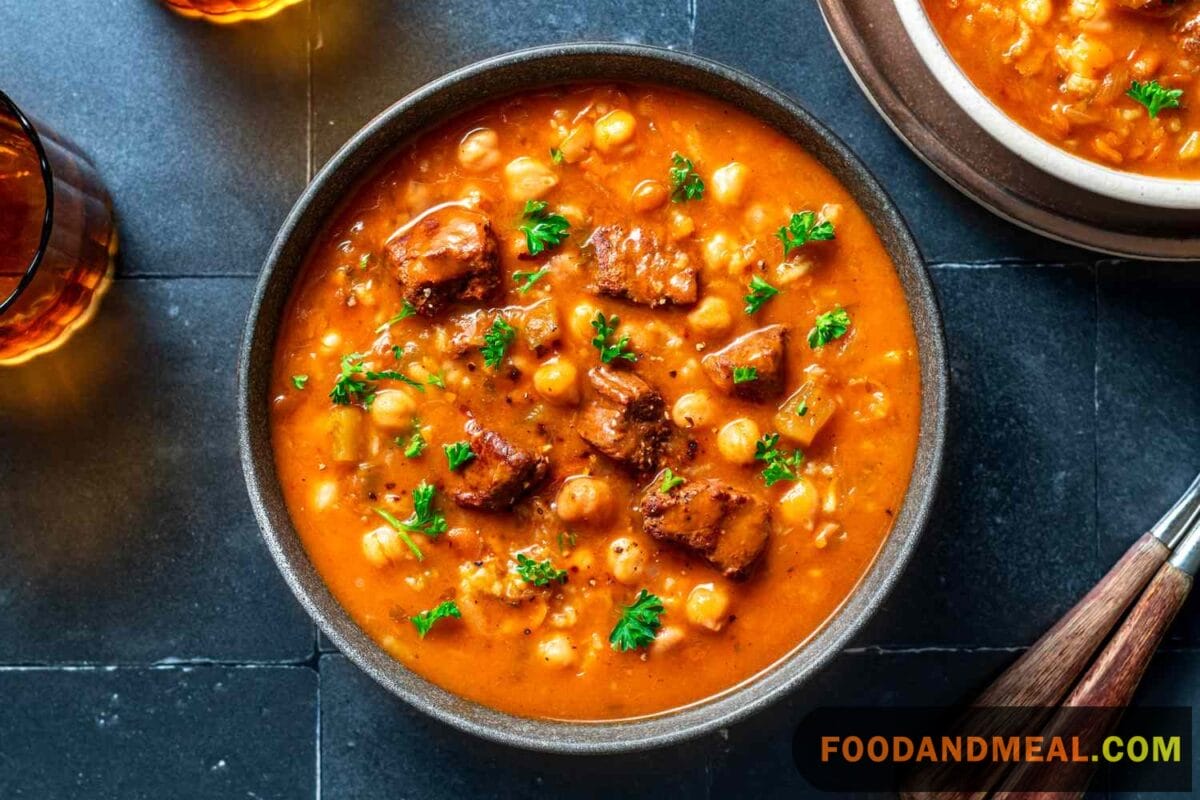
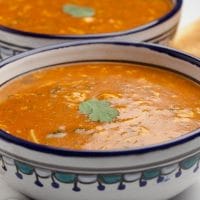
Moroccan Harira Soup Recipe
Equipment
Ingredients
- 8 ounces of diced lamb beef, or chicken
- 3 tablespoons of vegetable or olive oil
- Various soup bones optional
- 2 pounds of ripe and soft tomatoes about 6 large
- 1 handful of dry chickpeas soaked and peeled
- 2 handfuls of dried green or brown lentils
- 1 large onion grated
- 1 celery stalk leafy, chopped
- 1 bunch of flat parsley finely chopped
- 1 scoop of coriander finely chopped
- 1 tablespoon of Smen optional
- 1 spoon of salt
- 1 tablespoon of ginger
- 1.5 teaspoons of black pepper
- 1 teaspoon Ground cinnamon
- 1/2 teaspoon of turmeric
- 3 tablespoons of tomato paste combined with 1 or 2 cups of water
- 3 tablespoons of uncooked rice or sliced spaghetti
- 1 cup of flour combined with 2 cups of water
- Coriander and lemon wedges optional for garnish
Instructions
- Soak the chickpeas overnight. Drain and peel the next day. You can do this simply by pressing the chickpeas between your index finger and thumb or by vigorously rubbing on a cloth. (You can freeze the prepared chickpeas until ready to use.)
- Remove stones and dirt from the lentils. Reserve until you need it.
- Stew the tomatoes and put them in a food mill to obtain a puree. Throw away the skins and seeds. Alternatively, quarter the tomatoes and blend them in a food processor.
- Grate the onion or make a thick pulp using a food processor. (You can combine the grated onions with the tomato puree and freeze until needed.)
- Wash the celery and chop finely. Put it aside. Remove and remove large stalks of parsley and coriander. Wash the parsley and coriander and drain well before cutting by hand or in a food processor. (You can combine all the veggies together and put in the refrigerator until needed)
- Fry the meat in oil in a pressure cooker of at least 6 liters or in a pan over medium heat. Add the chickpeas, soup bones, tomato puree, spices, grated onions, smen (if used), and 3 cups of water. Leave it to boil, cover, and simmer at medium heat for 50-60 minutes.
- Add lentils, herbs, tomato puree, and 2 liters of water. Cover and leave to cook.
- Cook the soup over medium heat for 30 minutes. Add the rice and cook for further 15 minutes (or 30 minutes on low heat).
- However, if you want to use vermicelli, boil the soup over medium heat for 45 minutes before adding the broken noodles. Simmer for further few minutes until the noodles are soft.
- Adjust seasonings if needed. Add tedouira (flour and water mixture) to the soup to get silky, creamy consistency with constant stirring so that it is well mixed. Use only what you need to get the consistency you prefer.
- Cook the soup for further 5-10 minutes. Stir occasionally to remove the foam on the surface.
- Remove from the heat and serve.
Video
Notes
- A skin will form on the soup as it cools. This can be stirred and blended back into the soup.
- When reheating the soup, use medium or low heat and stir frequently to avoid lentils sticking to the bottom of the pot and burning.
- If you'd like to freeze the soup, do so before adding the thickener and preferably before adding the rice or broken vermicelli. Allow it to cool completely before freezing. On the day of serving, thaw the soup over low heat then resume cooking from where you left off.
- Lemon wedges may be served on the side for those who like a squeeze of fresh lemon juice as a condiment for the soup. If desired, garnish with a little fresh parsley or cilantro.
- Blending the flour and water tedouira ahead of time will help ensure that it's lump-free when adding it to the soup.
Nutrition
© Food And Meal
This website provides approximate nutrition information for convenience and as a courtesy only. Nutrition data is gathered primarily from the Spoonacular Database, whenever available, or otherwise other online calculators.
Alternative Method: Making Moroccan Harira Soup with a Pressure Cooker
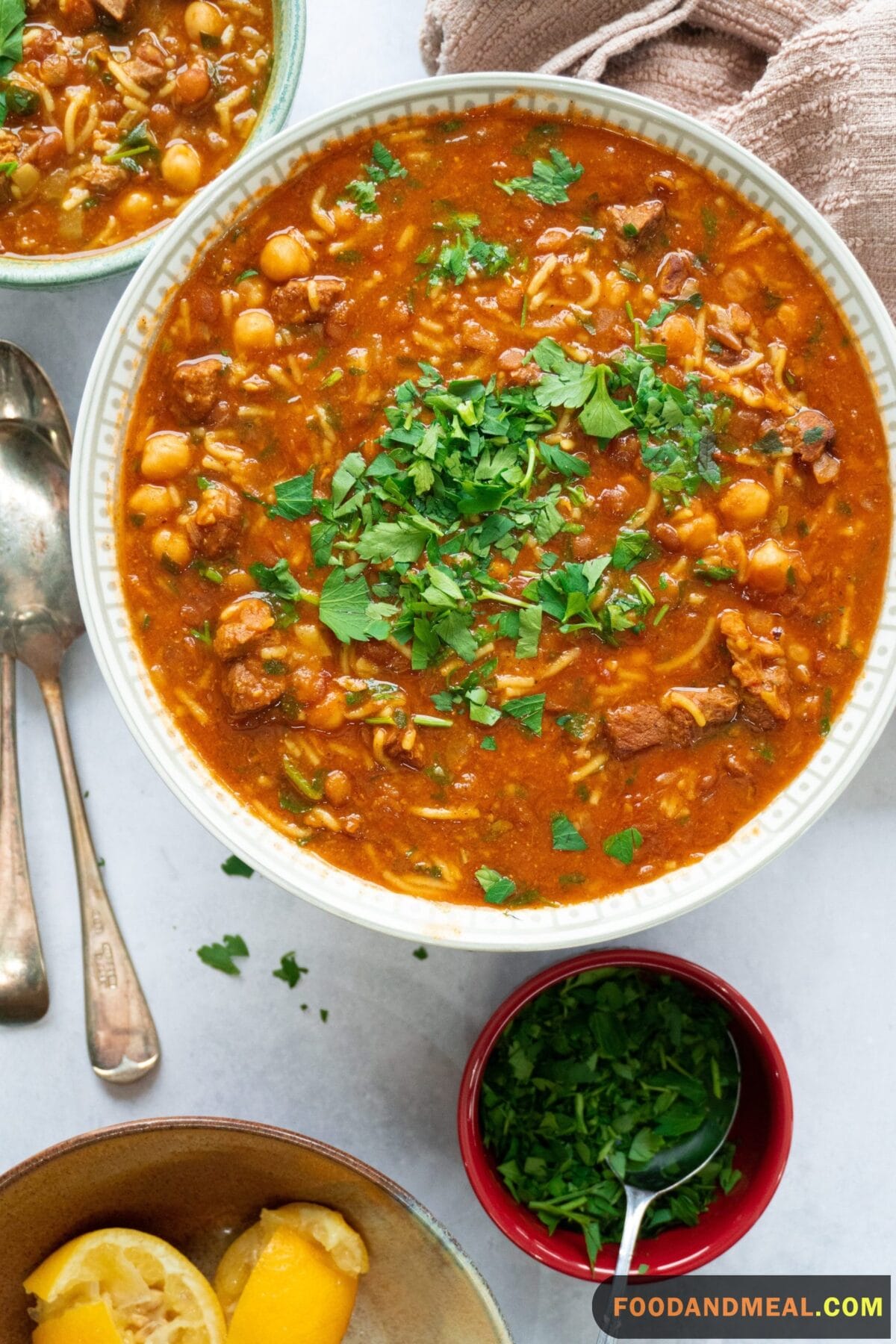
Start by rinsing and soaking dried chickpeas overnight or for a minimum of 6 hours, then drain and rinse them. As the pressure cooker awakens, set it to sauté mode, letting the olive oil dance in the heat. Add chopped onions, sautéing until they unveil their translucent beauty. Introduce minced garlic, and let it perfume the air for a couple of minutes. Stir in flour, allowing it to gracefully turn a light golden hue, ensuring not to flirt with burning. The stage is set for a symphony of spices; add ground cumin, ginger, cinnamon, turmeric, black pepper, and cayenne pepper, stirring until their aromatic dance unfolds. Now, bring in the soaked chickpeas, red lentils, chopped tomatoes, fresh cilantro, and parsley, uniting them in a flavorful chorus. Pour in 6-8 cups of vegetable broth, adjusting for your desired soup thickness, and season with salt. Seal the pressure cooker lid and let it work its magic for 15-20 minutes, the exact duration depending on your pressure cooker model. As the lid unveils, stir the soup, adding more broth if needed and fine-tuning the seasoning.
Tips for making Moroccan Harira Soup

Cooking Tips
Crafting this iconic dish requires a thoughtful approach, starting with quality ingredients like fresh produce and high-quality pulses, soaked overnight for ideal texture. Elevate the experience by toasting and grinding spices, considering meat choices like lamb, beef, or chicken, and allowing for slow simmering to infuse tradition and depth. Achieve the soup’s unique texture with a gradual introduction of “tedouira,” a flour-based paste. The addition of delicate herbs like coriander and parsley brings vibrance, while achieving balance through continuous taste-testing ensures nuanced harmony. Serving with sides like lemon, dates, or a hard-boiled egg enhances the experience, and above all, patience and love in the cooking process contribute to the final pleasure of enjoying Harira.
Serving Suggestions
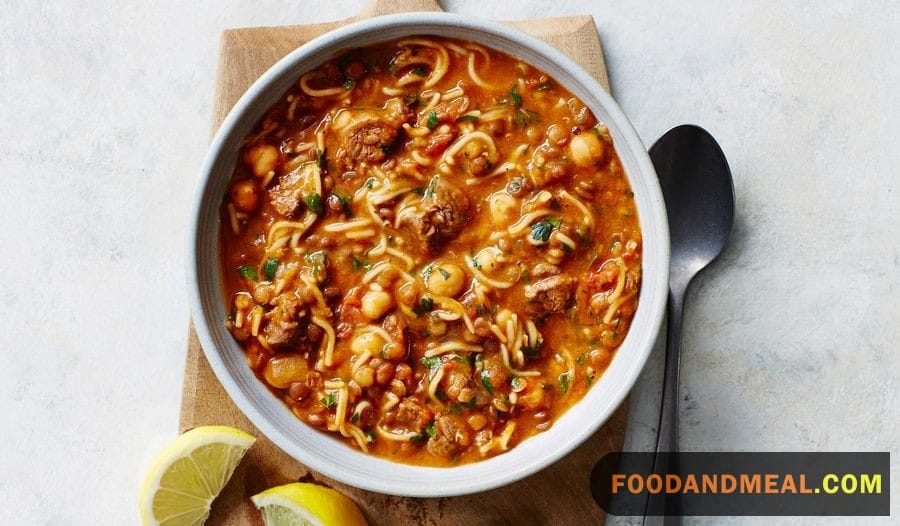
Traditionally enjoyed during Ramadan, breaking the fast with dates perfectly precedes savoring the rich depth of Harira. Alternatively, sweet mochi can offer a delightful post-soup sweetness outside of this context. Warm, grilled bread provides a textural delight for dipping, while a pesto panini introduces an Italian twist with aromatic herbs echoing Harira’s notes. To counterbalance the soup’s hearty richness, a crisp daikon salad dressed lightly with Ponzu sauce refreshes the palate between spoonfuls. Fragrant Persian rice transforms Harira into a more substantial meal without overshadowing its intense flavors. Soft-boiled, marinated Ajitama eggs, though unconventional, can be a savory side that complements the spices and textures in the soup. Fish tacos, while unexpected, cater to those who appreciate the fusion of sea flavors with spiced, tomato-based dishes. Cheese ramen, blending culinary traditions, offers a savory pairing for those who enjoy bold flavors. Almond or hazelnut milk serves as a mild, nutty refreshment to balance Harira’s spice-led profile.
FAQs (Frequently Asked Questions) about Moroccan Harira Soup
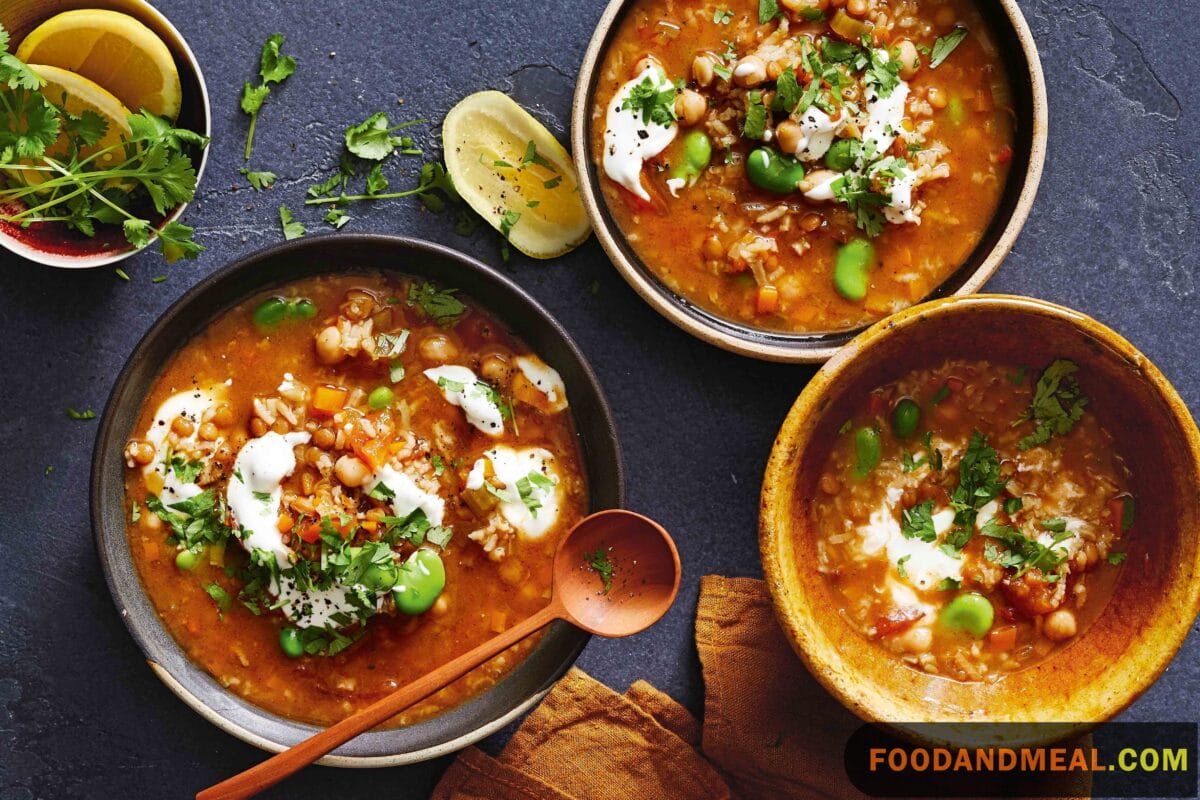
- Can I freeze Moroccan Harira Soup? Absolutely! Harira freezes well. Allow it to cool, place it in airtight containers, and freeze for up to 3 months.
- Is there a gluten-free option for Harira? Yes, you can substitute chickpea flour or a gluten-free flour blend for wheat flour in the recipe.
- Can I use canned chickpeas instead of dried ones? Yes, canned chickpeas are a convenient alternative. Rinse them before adding to the soup.
- What if I don’t have fresh cilantro and parsley? You can use dried herbs, but fresh herbs truly enhance the flavor. Consider growing a small herb garden for a handy supply.
- Is there a low-sodium version of Harira? You can reduce sodium by using low-sodium vegetable broth and adjusting the salt content to your preference.
Conclusion
In concluding a blog post about Moroccan Harira, it’s important first to recognize the dish’s cultural significance. Harira is a traditional Moroccan soup that is often associated with Ramadan, but it is also a staple in Moroccan cuisine that can be enjoyed year-round. The soup is a hearty blend of tomatoes, lentils, chickpeas, and often, meat, which is typically lamb. It is seasoned with a mix of fragrant spices such as turmeric, cinnamon, and ginger, as well as fresh herbs like cilantro and parsley. The aromatic profile of Harira is a testament to the rich and diverse culinary history of Morocco, where spices are used with a generous hand to create layers of flavor.
As we tie up the discussion on Harira, it’s worth noting the adaptability of this dish. While there are traditional recipes, Harira can be tailored to individual tastes or dietary restrictions. Vegetarians can omit the meat and double up on the legumes, and those who like a bit of heat can add chili peppers to their liking. This adaptability not only makes Harira a versatile option for various dietary preferences but also reflects the larger Moroccan ethos of hospitality, where dishes are often customized to please guests.
When considering the consumption of Harira, it’s typically served with a wedge of lemon to squeeze over the top, which adds a bright zing that complements the richness of the soup. It’s both a meal in itself and an appetizer, setting the stage for a larger feast to follow. Sharing a bowl of Harira can be a moment of connection and warmth, making it more than just sustenance but a means by which Moroccan culture and traditions are carried forward and shared.
For those interested in exploring this exquisite Moroccan dish, one might refer to resources such as Food And Meal or foodandmeal.com for recipes, cooking tips, and further insight into Moroccan cuisine and culture. These platforms often offer a variety of cooking guides that can help you bring a taste of Morocco into your kitchen, no matter where in the world you might be.
Hello! I’m Black Pie, your culinary guide at Food And Meal, Hana Hotel Travel Company Limited. I'm passionate about unveiling the rich and diverse flavors of African cuisine to the world. Each recipe we explore is a celebration of culture, tradition, and exquisite taste. Join me on this delightful culinary journey, where we'll discover and share the hidden gems of African cooking together!



